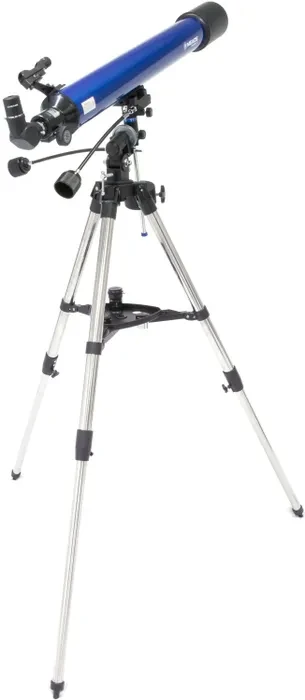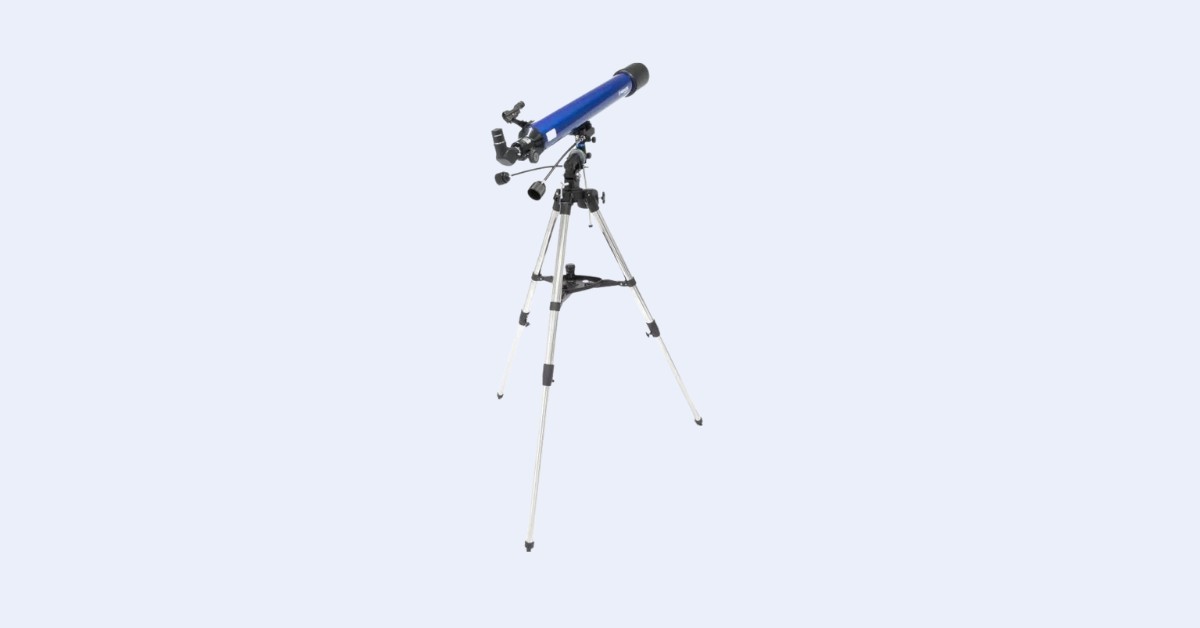The Optical Tube
The Meade Polaris 90 is a 90mm (3.5″) f/11 achromatic refractor telescope with a focal length of 1000mm. Like most achromats, the Polaris 90 employs a Fraunhofer configuration with crown and flint glasses for the two elements of the objective lens. At this size and relatively slow focal ratio, chromatic aberration is very well controlled for all but the brightest targets. I’ve observed slight purple halos around the Moon, Jupiter, Venus, and bright stars when using the telescope, but the Polaris 90 is capable of displaying sharp detail on small objects and pinpoint stars in most cases.
As with most refractors, the Polaris 90 features a built-in dew shield to manage condensation and stray light, and baffles are strategically positioned inside the tube to minimize internal reflections. The lens cell is plastic and not adjustable, should the telescope’s collimation be significantly disrupted; however, this is unlikely to become an issue since this rarely occurs with small refractors. Similar to many other entry-level telescopes, the Polaris 90 has a 1.25″ rack and pinion focuser predominantly made of plastic, which functions adequately as long as you avoid using heavy or costly eyepieces, although it may sag and wobble to some extent.

To attach to its mount, the Polaris 90 uses a Vixen-style dovetail fixed directly to the bottom of the optical tube, rather than with the intermediary of adjustable tube rings, which would allow for greater flexibility in balance.
Accessories
The Meade Polaris 90 comes with a 1.25″ Amici prism star diagonal, primarily designed for terrestrial viewing, and is mostly composed of plastic. The plastic housing is not a problem, but the (thankfully still glass) Amici prism inside is of subpar optical quality, resulting in internal reflections and glare. The Amici prism design inherently creates a bright spike on luminous objects. Additionally, this inexpensive Amici prism is so undersized that it actually vignettes your view when using low-power eyepieces. The included 26mm MA eyepiece is already beginning to vignette towards the edges of the field of view, and it doesn’t even max out the available field of view from a 1.25” barrel like a 32mm Plossl, for instance.
The three eyepieces provided with the Meade Polaris telescopes are plastic-bodied 1.25″ Meade MA 3-element eyepieces. Those accompanying the Polaris 90 are a 26mm (39x), a 9mm (111x), and a 6.3mm (159x), each of which can be used with the 2x Barlow to double their respective magnifications to 78x, 222x, and 318x with the Polaris 90. The 2x Barlow lens packaged with the Meade Polaris telescopes is mainly composed of plastic, much like the eyepieces. Although it performs surprisingly well, it isn’t exactly up to par with the quality of even a fairly inexpensive aftermarket Barlow in terms of sharpness and glare control.
The included 6.3mm MA eyepiece has very limited eye relief, requiring you to press your eye uncomfortably close to it to view anything, which of course also risks upsetting the aim of the telescope or causing vibrations. Moreover, the 159x magnification it delivers pushes the limits of the capabilities of the Polaris 90’s optics, given its aperture, and you can forget trying to use 318x because neither the telescope nor mount will handle such an absurdly high magnification.
The Polaris 90 also features an economical red-dot finder, which doesn’t quite match the quality usually found in Celestron and Sky-Watcher models. Although it works sufficiently and is an improvement over the low-quality 5×24 or 6×30 finders often included with beginner scopes, adjusting it to properly align it with the telescope can be difficult, the on/off switch is tiny, and the plastic window used to view the projected red dot is slightly tinted, diminishing the brightness of stars when you look through it. There are better red dot finders out there, and it would hardly have cost much to include one of those with this telescope.
The Polaris EQ2 Mount
The EQ2 equatorial mount supplied with the Meade Polaris telescopes is similar to the one supplied with the Celestron AstroMaster lineup and many other cheap beginner telescopes. It is a German equatorial mount design with 1.25” diameter steel tripod legs, a Vixen-style dovetail saddle to attach to the optical tube, and a pair of counterweights to balance the scope on the right ascension axis. It uses a lot of plastic parts and is a bit spindly, but it works well enough with the Polaris 90 optical tube.
The rather mediocre stability of the EQ2 mount can be improved by filling the tripod legs with spray foam or sand, and/or placing a heavy item, such as dumbbell weights or a water jug, on the accessory tray to lower the telescope’s center of gravity. There’s no provision for a polar scope, but the EQ2 mount can be equipped with a motor drive, such as the Celestron Logic Drive, for hands-free tracking of objects.
The EQ2 requires proper balancing with the telescope optical tube, like any equatorial mount. Typically, you would be able to slide the Polaris 90’s tube forward-backward in tube rings or move the dovetail bar itself for balancing along the declination axis, but the Polaris 90’s Vixen-style dovetail bar is so short and stubby that adjusting for balance on the declination axis is virtually impossible if the telescope becomes back-heavy with accessories. Balancing in right ascension is accomplished with the two provided counterweights. You can either leave the counterweights installed or mark the counterweight shaft with a permanent marker or tape to prevent having to determine balance every time you assemble your telescope. The mount also, of course, has flexible slow-motion cables for fine adjustment of your aim and to track objects by hand.
Should I buy a Used Meade Polaris 90?
A used Meade Polaris 90 might be worthwhile if one is available at an affordable price – though buying one new is not exactly something we’d recommend of course. Unfortunately, the plastic components on the Polaris 90’s mount and focuser are prone to damage by careless owners, and you should ensure the lens is free of any chips or obvious other defects like fungus or cracks. Nonetheless, there is little that can go wrong with a used Polaris 90 that won’t be immediately evident to even the most casual observer.
Alternative Recommendations
The Meade Polaris 90 offers poor value in its price range compared to many of the other high-quality reflectors, refractors, and catadioptric telescopes available.
Under $350
- The Sky-Watcher Heritage 130P boasts significantly more light-gathering ability, a wider field of view, and a sturdier mount than the Polaris 90, and is extremely portable due to its collapsible tube and tabletop Dobsonian mount.
- The Sky-Watcher Heritage 150P provides even more aperture than the Heritage 130P in the same compact, well-constructed package as the 130P and featuring the same collapsible tube and excellent accessory package too, with negligible increases in weight, volume, and price.
- The Zhumell Z114/Orion StarBlast 4.5 Astro features a larger aperture, a wider field of view, a steadier mount, and a much lower price tag than the Polaris 90.
- The Celestron StarSense Explorer LT 80AZ Refractor isn’t perfect and has slightly less aperture than the Polaris 90, but it is considerably easier to aim around the night sky thanks to its simpler alt-azimuth mount and Celestron StarSense Explorer technology.
$350-$550
- The Sky-Watcher Virtuoso GTi 150P shares the optics, accessories, and design of the Heritage 150P but adds fully motorized GoTo and tracking, controlled by your smart device and still able to be aimed freely without ruining the accuracy of its computerized pointing abilities. The Virtuoso GTi 130P uses the same mount as the GTi 150P but with a Heritage 130P optical tube.
- The Popular Science Celestron StarSense Explorer DX 100AZ Refractor and Celestron StarSense Explorer DX 102AZ have more chromatic aberration than the Polaris 90 but include slightly better accessories and simpler mounts with the added bonus of a much wider field of view, slightly more aperture, and easy aiming with Celestron’s StarSense Explorer technology.
- The Orion SkyQuest XT6 has a rock-solid Dobsonian mount that requires neither a table nor tripod, a large 6” primary mirror, and a high-quality 2” Crayford focuser. The Polaris 90 pales in comparison.
- The Sky-Watcher Virtuoso 90 provides similar views to the Polaris 90 but in a much more compact package with motorized tracking, no chromatic aberration, and better accessories provided by default, even including a solar filter.
Aftermarket Accessory Recommendations
The stock 1.25” Amici prism that comes with the Polaris 90 needs to go immediately. You should replace it with a quality 1.25” star diagonal, such as the Celestron 94115-A Prism Star Diagonal. Cheap mirror diagonals will provide a less-than-sharp image, and while a decent prism diagonal can seem expensive, it will drastically improve your views through the Polaris 90’s otherwise-great optics. Additionally, a Celestron Logic Drive allows the Polaris EQ-2 mount to automatically track the sky, freeing you from the need to make constant manual adjustments on the right ascension axis.
A 32mm Plossl eyepiece coupled with a new star diagonal will provide 31x magnification and a wider true field of 1.7 degrees, ideal for finding and viewing deep-sky objects with the Polaris 90. A 15mm redline or goldline eyepiece (67x) might be a useful addition to the Meade Polaris 90 as well.
Finally, a 6mm “goldline” or “redline” eyepiece will provide 167x with the Polaris 90, which is about the limit of what a 90mm telescope can handle in magnification. However, while higher power than 100x may show you slightly more on the planets and allow you to split closer double stars than with the provided 9mm MA, it comes at the expense of providing a shakier and very dim image.
What can you see?
The Meade Polaris 90 is not well-suited for viewing deep-sky objects due to its small aperture and long focal ratio. Galaxies will appear as faint smudges with only 90mm of aperture, even under dark skies, with the exception of the brightest galaxies, such as M31 and M82, which may show hints of dust lanes and other detail. Globular star clusters and planetary nebulae are unresolved, dim, and faint fuzzies with the Polaris 90, regardless of your light pollution conditions or lack thereof. Open star clusters like M41 and M29 are attractive in the Polaris 90, but the telescope’s limited field of view due to its long focal length means that larger clusters like the Pleiades or Double Cluster are not nearly as pleasing as what a low-power, wide-field instrument of similar aperture might show them to be.
The brightest emission nebulae, such as Orion (M42) and the Lagoon (M8), reveal their main gas clouds and interior star clusters, but their fainter wispy regions are less obvious with the Polaris 90 thanks to its small aperture, and the view of these objects is far from as stunning as when viewed through a larger telescope, especially if you are stuck under light-polluted skies. Double stars are a good test of your observing skill and the steadiness of your current seeing conditions. Thousands of double stars are fairly easy to find with the Polaris 90, appearing as colorful pinpoints at high magnification.
The Polaris 90’s sharp optics make it a decent performer on Solar System objects (i.e., the Moon and planets). You can just barely resolve the phases of Mercury on a good night; Venus is far easier. The Moon always delights with craters, mountains, ridges, and other details on any given night. Mars’ polar ice cap is visible most of the time with the Polaris 90. On the best nights when Mars is at its closest and seeing conditions permit, you can also resolve some dark markings on its surface.
Jupiter’s cloud banding, smaller atmospheric features like storms, and the Great Red Spot are usually able to be seen with the Polaris 90, along with its four large Galilean moons. Io and Europa are hard to resolve as clear disks, as are their high-contrast shadows when they transit in front of Jupiter, but Ganymede and Callisto should be no trouble to see as tiny orbs when they transit, with their shadows following close behind. You can also discern the rings and atmospheric bands of Saturn, the Cassini Division within the rings, and some of Saturn’s moons. Uranus and Neptune appear as indistinct dots through the Polaris 90, with their disks too minuscule to resolve and their moons too dim to observe; Pluto remains similarly elusive for a telescope of this size.



